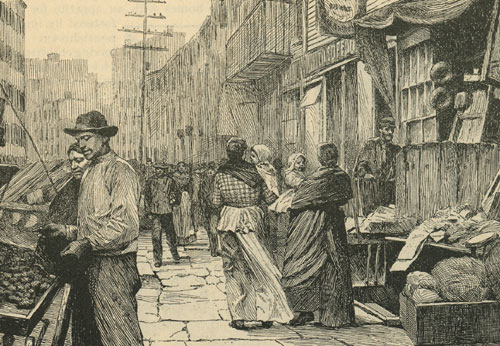
| Food and Shopping in the Lower East Side |
| HOME |
| New York City |
| Catherine Furst Schwartzmeier Lindemann | Minnie Goehle | Peter Goehle |
| Langans in New York City | Walshes in New York City | |
|
Food and Shopping Most tenement dwellings did not have refrigeration until the 1930s. In the summer time it was necessary to shop frequently since the food would not keep. The lack of refrigeration and storage required that food be bought in small quantities which is always more expensive that buying in bulk hence increasing the cost of food. The most common beverage was tea. In addition to permanent shops, there were open air markets, and peddlers selling their wares from push cards. The peddlers frequently were at the same location every day. Everything was sold off peddler's carts — food, bedding, toys, etc. Some carts were seasonal such as: Ice cream and lemonade in the summer — Hot potatoes and corn in the fall. Some types of produce were more readably available in one neighborhood versus another — clams were popular in Italian neighborhoods but not sold in Jewish neiborhoods. |

| Mulberry Street |
| Cosmo 1890, Co-Operative Housekeeping in Tenements by
Elizabeth Bislands, collection of Maggie Land Blanck
| |
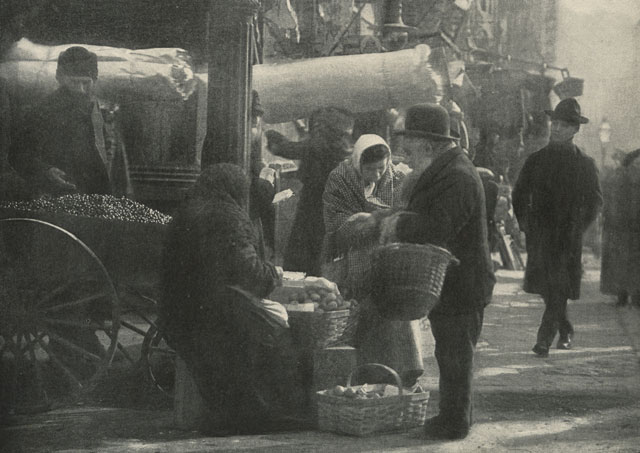
|
|
| Work, 1904 Lower East Side Shopping 1904 | |
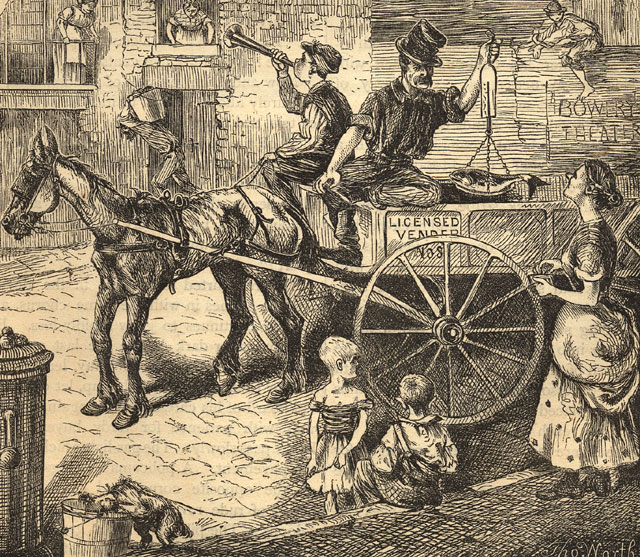 |
| Scribner's Monthly December 1879, Collection of Maggie Land Blanck |
| Fish Vender |
|
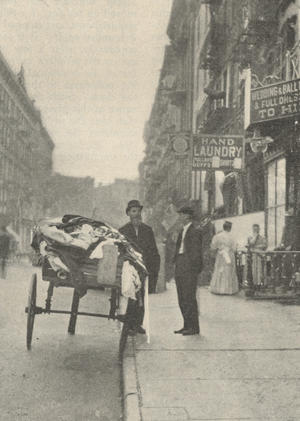 |
| Independent October 18, 1906, Collection of Maggie Land Blanck |
| Typical Peddler, Forsyth Street Near Grand |
|
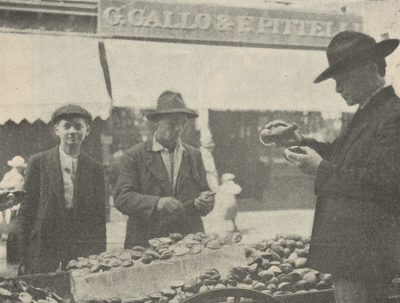 |
| Independent October 18, 1906, Collection of Maggie Land Blanck |
| Clam Seller in Mulberry Street |
|
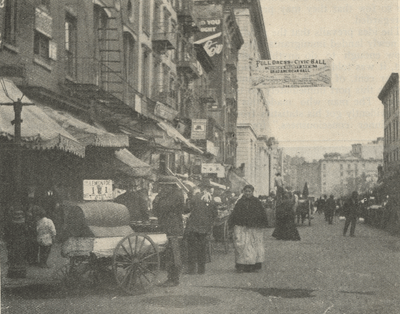 |
| Independent October 18, 1906, Collection of Maggie Land Blanck |
| Lemonade Seller, Hester and Ludlow Streets |
|
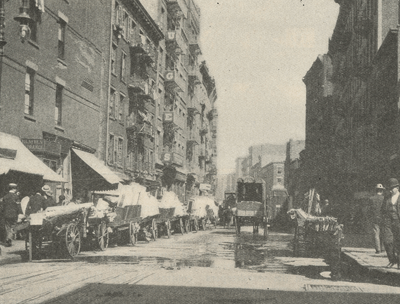 |
| Independent October 18, 1906, Collection of Maggie Land Blanck |
| Mulberry Street North from Hester |
|
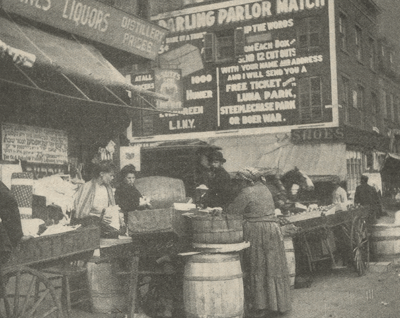 |
| Independent October 18, 1906, Collection of Maggie Land Blanck |
| Corner of Hester and Suffolk Streets |
|
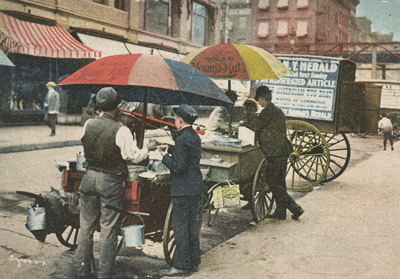 |
| Postcard collection of Maggie Land Blanck |
| New York Street Life. Ice Cream Venders. Posted 1903 |
|
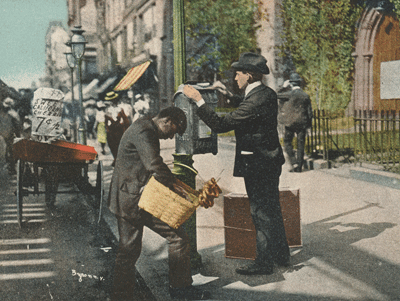 |
| Postcard collection of Maggie Land Blanck |
| New York Street Life. "Bretzel" Peddler. Not posted. |
|
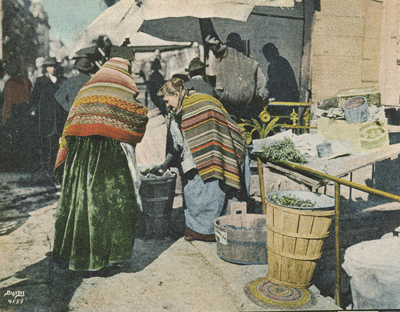 |
| Postcard collection of Maggie Land Blanck |
| New York Street Life. Vegtable Peddlers. Not posted. |
|
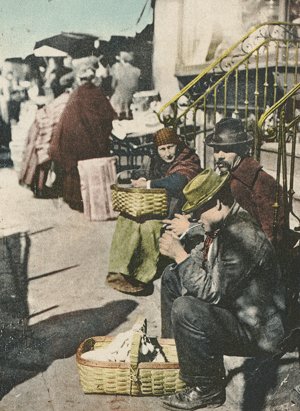 |
| Postcard collection of Maggie Land Blanck |
| New York Street Life. Cheese Venders on Mulberry Street. Not posted. |
|
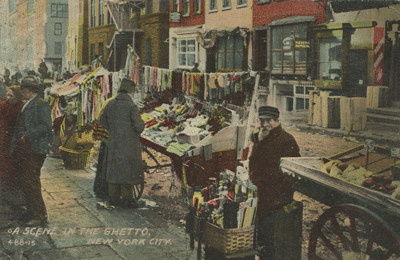 |
| Postcard collection of Maggie Land Blanck |
| A Scene in the Ghetto, New York City. Not posted |
|
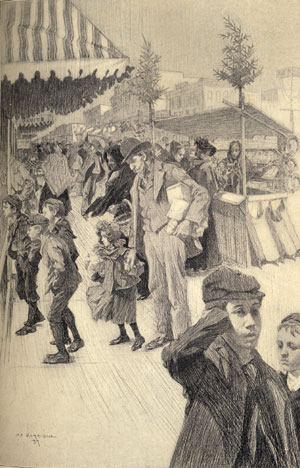 |
Christmas Shopping Avenue A While the women with their shawls pulled tight and the girl's blowing skirt indicate that the weather is at least chilly, no one is wearing an overcoat. |
| Children of the Tenement, Jacob A Riis
| |
| For more images of the streets and stores go to
Lower Manhattan
|
|
James Dabney McCabe Jr 1842-1883,
Lights and Shadows of New York, Sights and Sensations of the Great City,
1872 LXXXII. STREET VENDERS.
"It is not known how many stores, or places in which trade is conducted beneath the shelter of a roof, the city contains. They are numerous, but they are not sufficient for the wants of trade. The sellers overflow them and spread out into the streets and by-ways, with no roof above them but the blue sky. Some of these sellers are men, some women, and some mere children. Some have large stationary stands, others roam about with their wares in boxes, bags, or baskets in their hands. They sell all manner of wares. Watches, jewelry, newspapers, fruits, tobacco, cigars, candies, cakes, ice cream, lemonade, flowers, dogs, birds,--in short everything that can be carried in the hand--are sold by the Street Venders. The rich and the poor buy of them. The strolling vagrant picks up his scanty breakfast at one of these stands, and the millionaire buys an apple at another. |
| Tenement Life For general information about and pictures of life in the tenements, click on the image of the laundry in the tenement yards. |
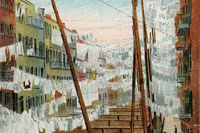 |
| Frank Leslie Illustrated Newspaper July 1, 1865 | |
| Children of the Tenements Click on image. |
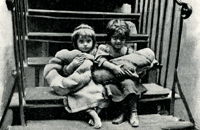 | |
| Contrasts in Life Style between the Haves and Haves Nots Click on image. |
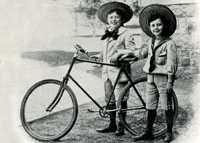 |
| Lower East Side Click on image. |
 |
| The Lower East Side Tenement Museum has information on the 1901 Tenement House Art at The Tenement House Act by Andrew Dolkart | ||
| The Lower East Side Tenement Museum's home page is at Lower East Side Tenement Museum | ||
| Catherine Furst Schwartzmeier Lindemann | Minnie Goehle | Peter Goehle |
| Langans in New York City | Walshes in New York City | |
To see my collection of images of lower Manhattan go to
Lower Manhattan
| To see my collection of images of the immigration experience go to
Immigration
| To see my collection of images of the immigration experience from Ireland go to
Irish Emigration
| James Dabney McCabe Jr 1842-1883
|
If you have any suggestions,
corrections, information, copies of documents, or photos that you would like to
share with this
page, please contact me at
maggie@maggieblanck.com | |
| RETURN TO TOP OF PAGE |
| Please feel free to link to this web page. You may use images on this web page provided that you give proper acknowledgement to this web page and include the same acknowledgments that I have made to the provenance of the image. Please be judicious. Please don't use all the images. You may quote up to seventy five words of my original text from this web page and use any cited quotes on this web page provided you give proper acknowledgement to this web page and include the same acknowledgments that I have made to the provenance of the information. Please do not cut and paste the whole page. You may NOT make use any of the images or information on this web page for your personal profit. You may NOT claim any content of this web page as your original idea. Thanks, Maggie |
| This page was created in 2010 from a preexisting page that was greated in 2005 : Latest update, May 2010 |